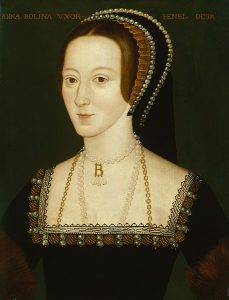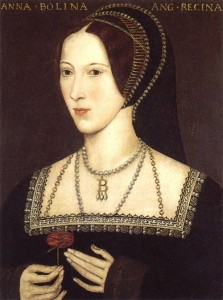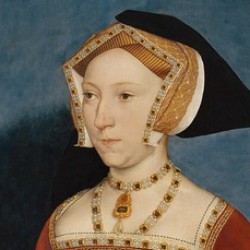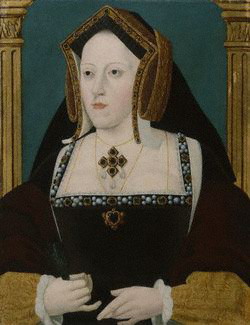 Anne Boleyn was the daughter of Thomas Boleyn, later Earl of Wiltshire, and Elizabeth Howard. She was the granddaughter of Thomas Howard, second Duke of Norfolk, and like all of Henry VIII’s wives, was descended from Edward I. Where Anne was born remains uncertain; traditionally Blickling Hall and Hever Castle, both of which were Boleyn properties, have been suggested, but a family tradition claimed that she was born in London, perhaps at Norfolk House, one of the seats of her mother’s family. Modern historians have usually assigned 1501 as the year of Anne’s birth, but two seventeenth-century texts nominated 1507. William Camden, the Elizabethan historian and herald, researched and wrote a life of Anne’s daughter, Elizabeth, in which, as Wyatt H. Herendeen notes, his ‘interpenetrating personal and professional lives were ‘authored’ by Elizabeth, while Burghley was his symbolic father.’ Entreating Camden to commence the project in the late 1590s, Burghley provided the historian with private papers as well as documents from the queen’s archives. This access, which included documents in Cotton’s library, ensured that Camden enjoyed ‘a privileged perspective’ on Elizabeth’s reign, as Herendeen contends. With the impressive resources available to him, it is questionable whether Elizabeth’s biographer would have erred in documenting her mother’s year of birth. Moreover, according to the memoirs of Jane Dormer, a favourite attendant of Mary I, Anne had not yet reached her twenty-ninth birthday when she was beheaded in 1536: an admission that supports a birth date of 1507.
Anne Boleyn was the daughter of Thomas Boleyn, later Earl of Wiltshire, and Elizabeth Howard. She was the granddaughter of Thomas Howard, second Duke of Norfolk, and like all of Henry VIII’s wives, was descended from Edward I. Where Anne was born remains uncertain; traditionally Blickling Hall and Hever Castle, both of which were Boleyn properties, have been suggested, but a family tradition claimed that she was born in London, perhaps at Norfolk House, one of the seats of her mother’s family. Modern historians have usually assigned 1501 as the year of Anne’s birth, but two seventeenth-century texts nominated 1507. William Camden, the Elizabethan historian and herald, researched and wrote a life of Anne’s daughter, Elizabeth, in which, as Wyatt H. Herendeen notes, his ‘interpenetrating personal and professional lives were ‘authored’ by Elizabeth, while Burghley was his symbolic father.’ Entreating Camden to commence the project in the late 1590s, Burghley provided the historian with private papers as well as documents from the queen’s archives. This access, which included documents in Cotton’s library, ensured that Camden enjoyed ‘a privileged perspective’ on Elizabeth’s reign, as Herendeen contends. With the impressive resources available to him, it is questionable whether Elizabeth’s biographer would have erred in documenting her mother’s year of birth. Moreover, according to the memoirs of Jane Dormer, a favourite attendant of Mary I, Anne had not yet reached her twenty-ninth birthday when she was beheaded in 1536: an admission that supports a birth date of 1507.
In 1514, Anne was transferred to the household of Mary Tudor, Queen of France, upon her marriage to Louis XII, a union that ended prematurely with the ageing king’s death in early 1515. Anne’s residence at the French court extended until late 1521, a period that saw her serve Claude, wife of Louis’s successor Francois I. It is possible, according to a contemporary tradition, that she also briefly resided in the household of Francois’ learned sister Marguerite, later Queen of Navarre. Anne’s upbringing and education in France were designed to encourage and accomplish the ambitions of her family. Until her recall in 1521, for example, it is possible that her father, who regularly served on diplomatic missions abroad, hoped that Anne would marry a French nobleman. When she was unexpectedly recalled to England, it was in readiness for her anticipated marriage to James Butler, prospective heir to the earldom of Ormond, a title also claimed by Thomas Boleyn.
The hostile Catholic tradition presented Anne as hideously deformed, with six fingers on one hand, a protruding tooth, and a number of goitres or warts. This lurid description is at odds with contemporary descriptions of Anne’s appearance dating to her residence at Henry VIII’s court. According to the Venetian ambassador, Anne was of medium height, with dark hair, a small bosom, a wide mouth and black eyes, which in his opinion were beautiful. Other observers were also fascinated by Anne’s eyes and their power to entrance and attract. Her French sojourn had equipped her with charm, confidence and an impressive understanding of European politics, as well as enhancing her talents in dancing and music making.
Whether Anne actually served in the household of Katherine of Aragon upon her arrival in England is uncertain, but she certainly featured at a pageant in March 1522 alongside seven noble women, including her sister Mary. The Chateau Vert pageant featured Anne as Perseverance and Mary as Kindness. At this time, her father was hoping that Anne would wed James Butler, but for reasons that remain unclear, the marriage ultimately came to nothing. According to George Cavendish, an attendant of Cardinal Wolsey, Anne became clandestinely betrothed to Henry Percy, heir to the earldom of Northumberland, a match that, had it succeeded, would have fulfilled her family’s ambitions. From Anne’s point of view, the title of Countess of Northumberland was undoubtedly superior to that of Ormond. However, in failing to obtain the support of her family and, more importantly, the king, whose involvement was expected in the marital negotiations of the premier nobility, Anne was expelled from court and seems only to have returned in about 1526. Cavendish’s hostile account claimed that it was during her exile from court that Anne nurtured her enduring hatred of the cardinal, whom she reportedly blamed for her plight, but Cavendish’s account is at odds with other evidence.Anne’s return to court saw her occupy the role of attendant to Katherine of Aragon, the third queen she served, the others being Mary and then Claude of France. The dating of Henry VIII’s infatuation with her remains contentious, but it was noted that he danced with her in May 1527 in the company of the visiting French envoys. At the same time, Wolsey was occupied with an investigation into the validity of Henry’s marriage to Katherine, an investigation, it was hoped, that would culminate in the annulment of the royal union. At this stage, Wolsey hoped that Henry would marry a French princess, perhaps Renee of France, but by 1528 it was clear that Henry was resolutely determined that his bride would be Anne. As she became more prominent at court, Anne’s family were also rewarded: her father was made Earl of Wiltshire and Ormond, while her brother George was elevated to the title Viscount Rochford. Ultimately, however, the Blackfriars Court failed to reach a resolution. The establishment of the Reformation Parliament and the laws that were enacted need not concern us here, but it is relevant, in view of longstanding debates about Anne’s religious opinions and the degree of influence she wielded, to consider her role in the eventual break with Rome. Undoubtedly, Anne provided Henry with religious treatises, including that penned by Simon Fish, that encouraged him to break from the papacy and govern his church in the same way as he governed his kingdom: as supreme head. Although the Imperial ambassador Chapuys was convinced that Anne and several members of her family were Lutheran, it is more accurate to characterise her religious opinions as evangelical, or as reformed. Her religious patronage as queen demonstrated her humanist interests, while her actions – including those undertaken during her imprisonment – confirmed her loyalty and devotion to the Catholic faith.
Although several historians have claimed that, as the dominant partner in the relationship, Anne encouraged Henry to break with Rome, expel Wolsey from court and deprive him of his offices, and treat Katherine and their daughter Mary with increasing cruelty, the evidence of Henry’s correspondence calls that judgement into question. Adopting a firm, placating tone, he showed a readiness to deny her requests, and after they had married, according to a hostile tradition, he was more than willing to remind Anne of his ability to lower her after having raised her. Whether that tradition can be validated cannot be resolved, but it is a reminder of the necessity to read ambassadorial reports and written memoirs with a critical eye, at a time when, of course, the adulterous woman served as a necessary – and useful – scapegoat for criticisms of the increasing severity of the government. That Katherine herself, and Mary by extension, blamed Anne for their plight there seems to be no doubt, but the events that accompanied Anne’s execution in 1536 proved a startling realisation for Mary of who was ultimately responsible for her harsh treatment.
The pinnacle of Anne’s career to date occurred on 1 September 1532, when she was made Marquess of Pembroke in her own right, an elevation that was succeeded by her departure with the king for France in readiness to meet with Francois I, who was believed to support their anticipated marriage. Sometime in December, Anne conceived, perhaps some weeks after her reported secret wedding with Henry on 14 November. A second marriage ceremony apparently took place on 25 January. These months were among the happiest of Anne’s life. On 1 June, she was publicly crowned queen in a spectacular ceremony that heralded her as mother of the anticipated prince, the restorer of peace and harmony to a kingdom increasingly riven with political and religious tensions. Ultimately, her child was not the longed-for son but a daughter, Elizabeth, born at Greenwich Palace on 7 September. The birth of Elizabeth merely added to the confusion felt by many of Henry’s subjects for, with two surviving daughters, it seemed uncertain which daughter could claim to be heir to the throne. The birth of a daughter was not a catastrophe, but it was something of a disappointment. However, by the New Year Anne believed herself to be with child once more.
During her tenure as queen, Anne enthusiastically supported the efforts of reformers and enjoyed good relations with Thomas Cranmer, Archbishop of Canterbury, and Thomas Cromwell, later vice-regent of spiritual affairs. She also concerned herself with the education and upbringing of her daughter, and made clear her preference for Elizabeth to learn classical languages. The surviving evidence indicates that Anne favoured close relations with France, but the coolness of the French in response to a prospective marriage alliance between Francois’ son and Elizabeth unsettled her. At a court occasion in early 1535, Anne confided to Gontier, a French envoy, her unease. Undoubtedly her concern was motivated mainly by her seeming inability to produce the much-desired male heir. Whether Anne experienced a miscarriage, stillbirth or phantom pregnancy in 1534 remains open to debate. In January 1536, shortly after the death of Katherine of Aragon, she miscarried a son. That event seems to have instilled doubt and fear in her husband, occurring as it did with his pursuit of Jane Seymour, an attendant of the queen.
 The three most prominent biographers of Anne, Eric Ives, Retha Warnicke and G.W. Bernard, have conceptualised Anne and interpreted her downfall in strikingly different ways, the resulting controversy of these analyses itself a tribute to Anne’s polarising character. According to Warnicke, Anne’s miscarriage in 1536 of a deformed son provided damning evidence that she was both a witch and an adulteress, with the April indictments charging her and her alleged lovers with sexual offences and conspiracy to murder the king, alongside rumours of her attempted poisonings of Henry Fitzroy, the king’s bastard son, and his daughter Mary. Ives and Bernard, by contrast, refuted the notion of a deformed child and allegations of witchcraft. Relying mainly on the correspondence of the Imperial ambassador Chapuys and the sermon preached by Anne’s almoner John Skip in April, Ives contended that it was Cromwell, rather than Henry, who was responsible for the queen’s downfall, motivated in part by their estrangement over the monasteries and in part by Cromwell’s desire to seek an alliance with the Emperor, an alliance allegedly obstructed by Anne. Bernard, however, utilised the correspondence of Lancelot de Carles, a French poet and diplomat, to support his argument that Anne actually was guilty of some, if not all, of the crimes with which she was charged.
The three most prominent biographers of Anne, Eric Ives, Retha Warnicke and G.W. Bernard, have conceptualised Anne and interpreted her downfall in strikingly different ways, the resulting controversy of these analyses itself a tribute to Anne’s polarising character. According to Warnicke, Anne’s miscarriage in 1536 of a deformed son provided damning evidence that she was both a witch and an adulteress, with the April indictments charging her and her alleged lovers with sexual offences and conspiracy to murder the king, alongside rumours of her attempted poisonings of Henry Fitzroy, the king’s bastard son, and his daughter Mary. Ives and Bernard, by contrast, refuted the notion of a deformed child and allegations of witchcraft. Relying mainly on the correspondence of the Imperial ambassador Chapuys and the sermon preached by Anne’s almoner John Skip in April, Ives contended that it was Cromwell, rather than Henry, who was responsible for the queen’s downfall, motivated in part by their estrangement over the monasteries and in part by Cromwell’s desire to seek an alliance with the Emperor, an alliance allegedly obstructed by Anne. Bernard, however, utilised the correspondence of Lancelot de Carles, a French poet and diplomat, to support his argument that Anne actually was guilty of some, if not all, of the crimes with which she was charged.
More recently, Greg Walker and Suzannah Lipscomb have drawn attention to Anne’s own suspicious behaviour and actions at the end of April, which undoubtedly arose from her own fear and unease in response to rumours that her marriage would shortly be annulled. Whatever the precise nature of Cromwell’s involvement, ultimately Henry VIII was responsible for the imprisonment, condemnation and execution of his wife on 19 May. His relief and happiness were reported by the incredulous Chapuys, while others openly questioned the charges and wondered whether the lurid accusations served as a smokescreen for the real cause of Anne’s downfall. Theories of a deformed child; a Cromwellian conspiracy; the actual uncovering of the queen’s guilt; a courtly game that backfired; Henry’s lust for Jane: all of these theories add to the mystery of the cause of the bloody events of May 1536. Even in the reign of Elizabeth, Protestant chroniclers were reluctant to discuss Anne’s downfall and merely praised her efforts in the reformed cause. Undoubtedly, her failure to provide Henry with a male heir was the primary factor in her downfall. As Henry approached his forty-fifth birthday, at a time when contemporaries usually associated the onset of old age with forty, his concern and unease about the future of his dynasty came to the fore. Even after the death of Anne and his resulting marriage to Jane, the king responded anxiously when his new bride did not immediately conceive. The scandalous reports that his wife had openly discussed his impotence and had engaged in adulterous liaisons added to Henry’s humiliation, while conveniently allowing him to rid himself of her and start afresh with a divinely approved union.
Written by Conor Byrne, author of Katherine Howard: A New History and Queenship in England: 1308–1485 Gender and Power in the Late Middle Ages. Conor is a British graduate with a degree in History from the University of Exeter. Conor has been fascinated by the Tudors, medieval and early modern history from the age of eleven, particularly the lives of European kings and queens. His research into Katherine Howard, fifth consort of Henry VIII of England, began in 2011-12, and his first extended essay on her, related to the subject of her downfall in 1541-2, was written for an Oxford University competition. Since then Conor has embarked on a full-length study of queen Katharine's career, encompassing original research and drawing on extended reading into sixteenth-century gender, sexuality and honour. Some of the conclusions reached are controversial and likely to spark considerable debate, but Conor hopes for a thorough reassessment of Katherine Howard's life. Conor runs a historical blog which explores a diverse range of historical topics and issues. He is also interested in modern European, Russian, and African history, and, more broadly, researches the lives of medieval queens, including current research into the defamed 'she-wolf' bride of Edward II, Isabella of France.
Conor is currently studying for a Masters.





Excellent article, informative & grippingly entertaining.
This is a good article.